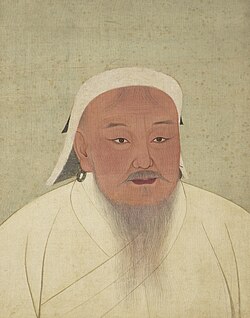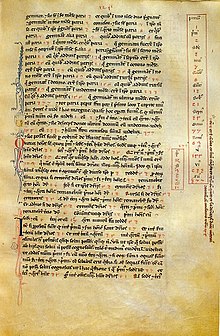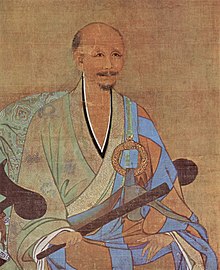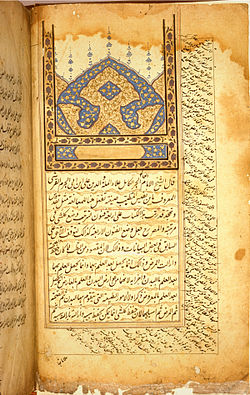13th century
Appearance
| Millennium |
|---|
| 2nd millennium |
| Centuries |
| Timelines |
|
| State leaders |
| Decades |
| Categories: |
|
Births – Deaths Establishments – Disestablishments |

The 13th century was the century which lasted from January 1, 1201 (represented by the Roman numerals MCCI) through December 31, 1300 (MCCC) in accordance with the Julian calendar.
The
Bakhtiyar Khilji. The earliest Islamic states in Southeast Asia formed during this century, most notably Samudera Pasai.[1] The Kingdoms of Sukhothai and Hanthawaddy would emerge and go on to dominate their surrounding territories.[2]
Europe entered the apex of the
fourth, while mostly unsuccessful in rechristianizing the Holy Land, inspired the desire to expel Muslim presence from Europe that drove the Reconquista and solidified a sense of Christendom. To the north, the Teutonic Order christenized and gained dominance of Prussia, Estonia, and Livonia. Inspired by new translations into Latin of classical works preserved in the Islamic World for over a thousand years, Thomas Aquinas developed Scholasticism, which dominated the curricula of the new universities.[3] In England, King John signed the Magna Carta, beginning the tradition of Parliamentary advisement in England. This helped develop the principle of equality under law in European judisprudence.[4]
The
Southern Song dynasty began the century as a prosperous kingdom but were later invaded and annexed into the Yuan dynasty of the Mongols. The Kamakura Shogunate of Japan successfully resisted two Mongol invasion attempts in 1274 and 1281. The Korean state of Goryeo resisted a Mongol invasion, but eventually sued for peace and became a client state of the Yuan dynasty.[5]
In North America, according to some population estimates, the population of Cahokia grew to be comparable to the population of 13th-century London.[6] In Peru, the Kingdom of Cuzco began as part of the Late Intermediate Period. In Mayan civilization, the 13th century marked the beginning of the Late Postclassic period. The Kanem Empire in what is now Chad reached its apex. The Solomonic dynasty in Ethiopia and the Zimbabwe Kingdom were founded.
Events

1201–1209
- 1202: Introduction of Liber Abaci by Fibonacci.
- Seljuks.
- John of England.
- Bakhtiyar Khalji and oppression of Buddhism in East India.
- 1204: Fourth Crusade of 1202–1204 captures Zadar for Venice and sacks Byzantine Constantinople, creating the Latin Empire.
- Philip Augustus, end of Normandomination of France.
- Baldwin I, (July 1172 – 1205), the first emperor of the Latin Empire of Constantinople.
- the Mongols.
- 1206: The Delhi Sultanate is established in Northern India under the Mamluk Dynasty.
- Franciscan Order.
- 1209: The Albigensian Crusade is declared by Pope Innocent III.
1210s

- pommelof the saddle pierced his ribs.
- forces.
- 1213: The Kingdom of France defeats the Crown of Aragon at the Battle of Muret.
- 1214: France defeats the English and Imperial German forces at the Battle of Bouvines.
- 1215: King John signs Magna Carta at Runnymede.
- 1216: Battle of Lipitsa between Russian principalities.
- 1216: Maravarman Sundara I reestablishes the Pandya Dynasty in Southern India
- Crusaderswithdraw.
1220s
- C. 1220: The Kingdom of Mapungubwe dissolves
- 1220: The Kingdom of Zimbabwe begins
- Mongol conquest of the Khwarazmian Empire.
- 1222: Andrew II of Hungary signs the Golden Bull which affirms the privileges of Hungarian nobility.
- 1223: The Signoria, of the Republic of Venice is formed and consists of the Doge, the Minor Council, and the three leaders of the Quarantia.
- 1223: The Mongol Empire defeats various Russian principalities at the Battle of the Kalka River.
- 1223: Volga Bulgaria defeats the army of the Mongol Empire at the Battle of Samara Bend.
- 1225: Trần dynasty of Vietnam was established by Emperor Trần Thái Tông ascended to the throne after his uncle Trần Thủ Độ orchestrated the overthrow of the Lý dynasty.
- 1227: Estonians are finally subjugated to German crusader rule during the Livonian Crusade.
- 1227: Genghis Khan dies.
- Crusader States.
- Gregory IX and Frederick II.
- 1226–1250: Dispute between the so-called second Lombard League and Frederick II.
1230s

- 1232: The Mongols besiege Kaifeng, the capital of the Jin dynasty, capturing it in the following year.
- Isyana Dynasty and started his own Rajasa dynasty.
- 1235: The Mandinka tribes unite to form the Mali Empire which leads to the downfall of Takrur in the 1280s.
- Papacy.
- Kievan Rus.
- 1238: Sukhothai becomes the first capital of Sukhothai Kingdom.
1240s
- 1240: Russians defeat the Swedish army at the Battle of the Neva.
- 1241: Mongol Empire defeats Hungary at the Battle of Mohi and defeats Poland at the Battle of Legnica. Hungary and Poland ravaged.
- Battle of Lake Peipus.
- PapacyWar.
- Battle of La Forbie.
- 1249: End of the Portuguese Reconquista against the Moors, when King Afonso III of Portugal reconquers the Algarve.
- AyyubidDynasty.
1250s
- Coastal Coles Creek culture.[8]
- Mamluk dynastyis founded in Egypt.
- 1257: Baab Mashur Malamo established the Sultanate of Ternate in Maluku.
- 1258: Baghdad captured and destroyed by the Mongols, effective conclusion of the Abbasid Caliphate in Baghdad.
- 1258: Pandayan Emperor Jatavarman Sundara I invades Eastern India and northern Sri Lanka.
- 1259: Treaty of Paris is signed between Louis IX and Henry III
1260s
- 1260: Mongols first major war defeat in the Battle of Ain Jalut against the Egyptians.
- 1260: Great Khan.
- Crusaders and Venice.
- 1262: Iceland brought under Norwegian rule, with the Old Covenant.
- 1265: Dominican theologian Thomas Aquinas begins to write his Summa Theologiae.
- 1268: Fall of the Crusader State of Antioch to the Egyptians.
1270s

- 1270: Goryeo dynasty swears allegiance to the Yuan dynasty.
- 1270: The Zagwe dynasty is displaced by the Solomonic dynasty.
- Baibars.
- Church of Rome.
- 1274: The Mongols launch their first invasion of Japan, but they are repelled by the Samurai and the Kamikaze winds.
- 1274: The Tepanec give the Mexica permission to settle at the islet Cauhmixtitlan (Eagle's Place Between the Clouds)
- 1275: Sant Dnyaneshwar who wrote Dnyaneshwari (a commentary on the Bhagavad Gita) and Amrutanubhav was born.
- Pamalayu expedition against Melayu Kingdomin Sumatra (ended in 1292).
- 1277: Passage of the last and most important of the Paris Condemnations by Bishop Tempier, which banned a number of Aristotelian propositions
- 1279: The Song dynasty ends after losing the Battle of Yamen to the Mongols.
- Chola Dynastyin Southern India officially comes to an end.
1280s
- 1281: The Mongols launch their second invasion of Japan, but like their first invasion they are repelled by the Samurai and the Kamikaze winds.
- 1282: Aragon acquires Sicily after the Sicilian Vespers.
- 1284: Peterhouse, Cambridge founded by Hugo de Balsham, the Bishop of Ely.
- 1284: King Kertanegara launches the Pabali expedition to Bali, integrating Bali into the Singhasari territory.
- Mongol raid against Hungary, led by Nogai Khan.
- Mamluks led by Qalawun.
1290–1300
Philippe le Bel (seated). As duke of Aquitaine
, Edward was a vassal to the French king.- The Mamluk Dynasty comes to an end and is replaced by the Khalji dynasty.
- 1290: By the Edict of Expulsion, King Edward I of England orders all Jews to leave the Kingdom of England.
- forms.
- Mamluk Sultan of Egypt al-Ashraf Khalil captures Acre, thus ending the Crusader Kingdom of Jerusalem (the last Christian state remaining from the Crusades).
- Singhasari kingdom.
- Samudera and Lambri.[11]
- 1292: King Mangrai founds the Lanna kingdom.
- 1293: Mongol invasion of Java.[12] Kublai Khan of Yuan dynasty China, sends punitive attack against Kertanegara of Singhasari, who repels the Mongol forces.
- 1293: On 10 November, the coronation of Nararya Sangramawijaya as monarch, marks the foundation of the Hindu Majapahit kingdom in eastern Java.
- 1296: First War of Scottish Independence begins.
- 1297: Membership in the Mazor Consegio or the Great Council of Venice of the Venetian Republic is sealed and limited in the future to only those families whose names have been inscribed therein.
- 1299: Ottoman Empire is established under Osman I.
- established in the Acehregion.
- 1300: Aji Batara Agung Dewa Sakti founds the Kingdom of Kutai Kartanegara/Sultanate of Kutai in the Tepian Batu or Kutai Lama.
- 1300: The Turku Cathedral was consecrated in Turku.[13]
- Rajahnate of Cebuin Cebu Island on the Philippine Archipelago.
Inventions, discoveries, introductions
Alai Gate and Qutub Minar were built during the Mamluk and Khalji dynasties of the Delhi Sultanate.[14]
- Early 13th century – Southern Song dynasty (now in Nelson-Atkins Museum of Art, Kansas City, Missouri).
- The motet form originates out of the Ars antiqua tradition of Western European music.
- Manuscript culture develops out of this time period in cities in Europe, which denotes a shift from monasteries to cities for books.
- Pecia system of copying books develops in Italian university-towns and was taken up by the University of Paris in the middle of the century.
- Wooden Wang Zhen in 1298.
- The earliest known handgunsare made by the Chinese for use in warfare.
- The Chinese adopt the Islamic world.
- Southern Song dynasty. It is now kept at Percival David Foundation of Chinese Art, London.
- 1250 – Ancestral Pueblo architectural complexes reach their apex[15]
- Eyeglassesare invented in Venice, Italy.
- Late 13th century – Night Attack on the Sanjo Palace is made during the Kamakura period. It is now kept at Museum of Fine Arts, Boston.
- Late 13th century – raigo triptych, is made, Kamakura period. It is now kept at the Art Institute of Chicago.
- The Neo-Aramaiclanguages begin to develop during the course of the century.
See also
References
- ^ "Samudra Pasai worthy to be world historical site". Republika Online. 2017-03-24. Retrieved 2020-01-24.
- ISBN 978-0-8248-0368-1.
- ^ "St. Thomas Aquinas". Catholic Encyclopedia. Retrieved 2023-12-09.
- ^ Brooks, Christopher (2020). Western Civilization: A Concise History. NSCC Libraries Pressbooks.
- ISBN 9780275958237.
- ISBN 1405049251
- ^ "Ken Angrok". Encyclopædia Britannica. Retrieved 25 July 2010.
- ^ Weinstein, Richard A.; Dumas, Ashley A. (2008). "The spread of shell-tempered ceramics along the northern coast of the Gulf of Mexico" (PDF). Southeastern Archaeology. 27 (2). Archived from the original (PDF) on 2012-04-25.
- ISBN 0-8135-1304-9.
- ISBN 9004061967– via Google Books.
- ^ "History of Aceh". Archived from the original on August 13, 2012.
- ISBN 0-609-80964-4.
- ^ "Kenelle kellot soivat? – Kiipeä 360-videon avulla Turun tuomiokirkon torniin". Yle Uutiset (in Finnish). 2017-07-02. Retrieved 2023-02-10.
- ^ "Qutb Minar and its Monuments, Delhi". UNESCO World Heritage Centre. Retrieved 2023-02-10.
- ^ Berlo and Phillips, 275
External links
- James J. Walsh (1907). "The Thirteenth: Greatest of Centuries". nd.edu. Archived from the original on 2017-03-01.
